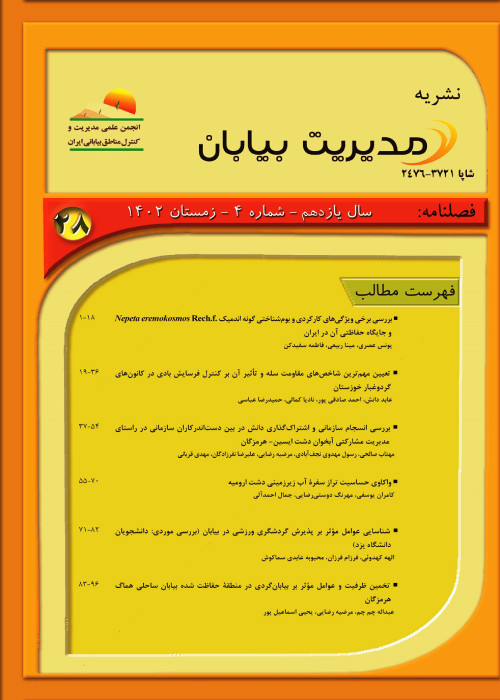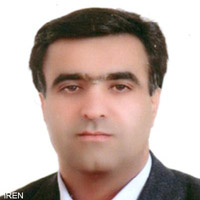Investigating the Trend of Dust Changes in The Eastern Half of Iran
The impact of dust storms on the ecosystem, human health, and economy is significant in the affected areas. In arid and semi-arid regions, dust is a natural occurrence that covers about one third of the earth's surface. This phenomenon is caused by wind erosion and factors such as the size of soil particles and their adhesion force, surface roughness, weather conditions such as long-term droughts cause it to intensify. To understand the impact of the dust phenomenon on humans and the environment, it is essential to evaluate the spatial and temporal distribution of dust and its changes and effects. Numerous studies have been carried out in the field of evaluating dust changes using different methods. For example, using CMIP5 models, synoptic fog systems are predicted to increase during the 21st century in the Middle East. In addition, using AOD obtained from MODIS and MERRA-2 sensors, researchers showed a significant upward trend in dust changes from 2000 to 2010. A significant upward trend was shown in Iran's winter AOD values during the period 2000 to 2010, and a decreasing trend during the period 2010 to 2018. A point can be spotted by examining various studies in the Middle East and Iran that evaluate the spatio-temporal changes of dust. Statistical tests of time series study, such as Mann-Kendall spatially and pixel by pixel, have been used in limited research to evaluate the trend of dust changes. In Iran, there is a research gap in not using spatial and pixel-by-pixel statistical tests to evaluate the trend of dust changes, as stated. This research aimed to provide a solution and address the problem by analyzing the spatial and temporal changes of dust using the AOD index in the eastern half of the country.
In this research, in order to evaluate the temporal-spatial changes of dust, the AOD data of the blue band (470 nm) of the MCD19A2 product of the MODIS sensor was used. AOD parameter is known as one of the most key factors in studying the climatic effects of aerosols and atmospheric pollution. In order to extract AOD data, monthly data from 2001 to 2022 were obtained in the Google Earth Engine system by averaging the daily AOD data. Over a 22-year period, the average of each month was calculated. The months that had the highest average AOD values were chosen and their changes were evaluated. In this research, the Mann-Kendall test was used to evaluate the change process. Menkendall's ZM coefficient was calculated for months in the Earth Trend Modeler (ETM) of the TerrSet software to achieve this. In the next step, the intensity of monthly AOD changes per time unit was calculated for 22 years in selected months. To simulate the process of changes, linear regression analysis can be utilized for this purpose. This method is used to determine the linear relationship between all the data of a dependent variable and the corresponding data of the independent index. If the slope is higher than zero, the dependent variable will change in the same direction as the independent variable. The dependent variable changes in the opposite direction of the independent variable if the slope is smaller than zero. The steeper the slope of changes, the greater the impact of the independent variable on the dependent variable. The Earth Trend Modeler (ETM) of TerrSet software also carried out this step.
Based on the evaluation of the monthly average AOD changes in the studied area, the trend and intensity of AOD changes from 2001 to 2022 were assessed in April, May, June, and July. In most areas of the studied area, AOD is increasing with a probability of more than 70%, and the intensity of changes is mostly high and very high in April. It can be concluded that AOD is experiencing a strong increase in April. This is despite the fact that in May, June and July, respectively, a considerable part of the western half, northern half and eastern half is increasing with different intensities with a probability of more than 70%. It can be concluded that the trend and intensity of AOD changes in the above-mentioned months follow a different spatial pattern. The dispersion of dust production centers inside and outside Iran, and the local and regional synoptic conditions governing dust production centers is the cause of changes in the spatio-temporal patterns of dust storms. The unprincipled extraction of water resources by humans, land degradation, soil moisture reduction, and the loss of vegetation due to climate change all affect these factors in turn. The results showed that the monitoring of monthly average AOD changes can help to identify new hotspots and evaluate the results of wind and dust erosion control and management activities. Therefore, it can be suggested that a system based on remote sensing must be designed and presented to monitor dust changes, so that the management of the dust phenomenon in Iran becomes more. We need to pay attention to the factors that influence these changes and evaluate their impact on the dust phenomenon. On the other hand, by modeling the environmental factors affecting on the trend of dust changes in each region by using methods such as dust evaluation, it is possible to determine the role of each factor and the most important factor affecting the trend of dust changes in each region.
- حق عضویت دریافتی صرف حمایت از نشریات عضو و نگهداری، تکمیل و توسعه مگیران میشود.
- پرداخت حق اشتراک و دانلود مقالات اجازه بازنشر آن در سایر رسانههای چاپی و دیجیتال را به کاربر نمیدهد.




